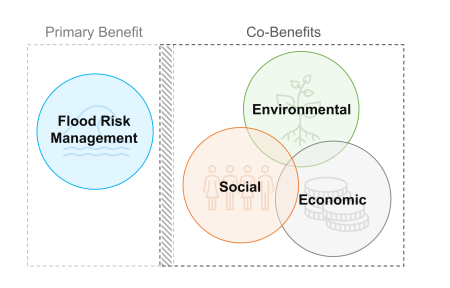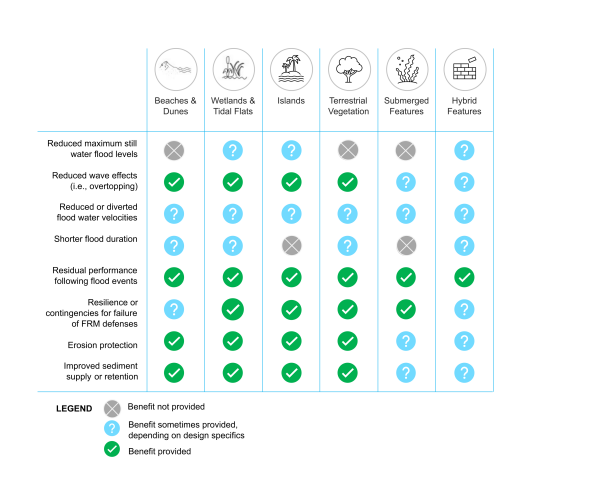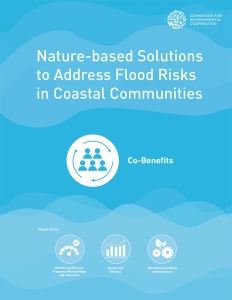Coastal communities across North America face increasing flood and erosion risks due to climate change. Rising sea levels, stronger and more frequent storm events and hurricanes, and continued development of the coast contribute to increasing pressures and risks of flooding and erosion. While traditional grey infrastructure—like seawalls and levees—continues to play a role, nature-based solutions (NbS) provide an alternative option for managing coastal hazards while also providing a wide range of environmental, social and economic benefits or ‘co-benefits’.
What are nature-based solutions?
Nature-based solutions are actions that protect, sustainably manage, or restore natural or modified ecosystems in ways that address societal challenges—such as climate change, flood risk and erosion—while also providing economic, environmental and social benefits.
In the context of coastal flooding, NbS include systems like wetlands, dunes, mangroves, reefs, barrier islands and beaches. These natural features have long played a protective role along coastlines by absorbing wave energy, slowing erosion and buffering storm surges. They can be restored, enhanced or integrated into existing or new coastal infrastructure to help mitigate the risks of coastal hazards.
The hidden Value: Understanding co-benefits
Co-benefits are the benefits provided by these coastal ecosystems and habitats that are additional to the benefits of coastal hazard risk management. These can include:
- Environmental: Improved water quality, habitat and biodiversity enhancement, and increased carbon sequestration from vegetated systems like marshes and mangroves
- Social: Expanded access to recreational spaces, stronger community identity, mental health benefits and cultural preservation, particularly for Indigenous and coastal communities
- Economic: Local job creation, improved fisheries and ecotourism, increased property values and often lower long-term maintenance costs compared to traditional infrastructure

Why co-benefits should influence decision-making
Because these co-benefits often fall outside the scope of conventional project evaluation methods, they are frequently undervalued or overlooked. Understanding and valuing co-benefits from the outset can dramatically improve project outcomes. When co-benefits are factored into planning and evaluation:
- Project prioritisation improves, helping decision-makers select interventions that deliver the highest overall value
- Community engagement strengthens, as residents connect more deeply with projects that reflect their needs and values
- Return on investment increases, especially over the long term, as many co-benefits accumulate or multiply over time
However, the uptake of NbS continues to face several persistent barriers:
- Social: Perceptions that NbS are less reliable than built infrastructure
- Technical: Limited data and methods for measuring co-benefits, especially in monetary terms
- Environmental: Natural variability can make outcomes less predictable
Institutional: Inflexible funding structures and lack of cross-sector collaboration can slow or prevent adoption
A new report to guide action
To help advance the use of NbS in coastal flood risk management, DHI prepared a series of reports for the Commission for Environmental Cooperation (CEC) on Nature-based Solutions to Address Flood Risks in Coastal Communities. The ‘Co-Benefits of Nature-based Solutions for Flood Risk Management in Coastal Areas’ guidance document is intended to support the uptake of NbS in coastal communities by providing decision makers, community leaders and flood risk management professionals with practical information and guidance related to NbS co-benefits and by addressing data gaps and barriers. It introduces a Co-Benefits Assessment Framework to support consistent and transparent evaluation of NbS projects, set out in three stages with a step-by-step guide for each stage. These stages are:
- Identification: Screening relevant co-benefits based on project and community context
- Valuation: Applying qualitative and quantitative methods to assess the magnitude and importance of each benefit
- Comparison: Weighing trade-offs and synergies to inform project design and investment decisions
The report emphasises the need for stakeholder involvement, multi-disciplinary collaboration and adaptive management throughout the process. Early assessment of co-benefits can help establish baseline conditions, support long-term monitoring and enable continuous learning to improve future projects.

The report also includes case studies from across North America, such as salt marsh restoration, oyster reef restoration and hybrid dyke–marsh systems. These examples show how NbS have been successfully implemented and how co-benefits can be effectively realised, emphasising the need to plan for co-benefits alongside engineering design; and highlights opportunities for future initiatives.
Explore the full report: Co-Benefits of Nature-based Solutions for Flood Risk Management in Coastal Areas









